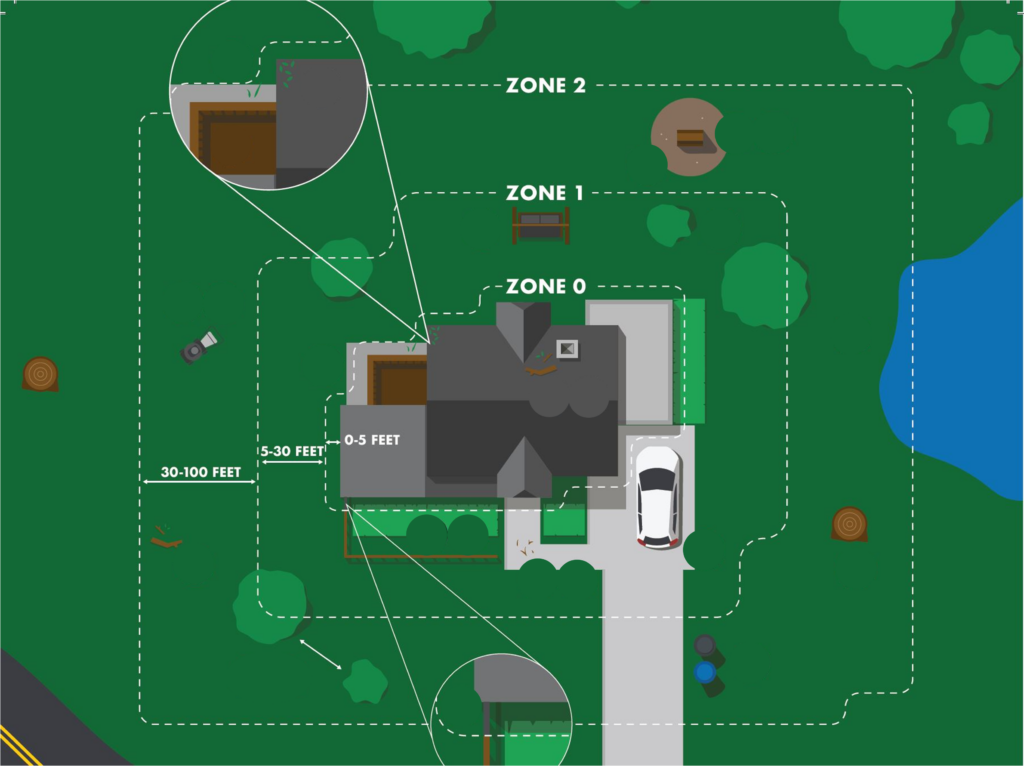Defensible Space Zones
Keep your property lean and green to help protect your school’s structures.
Defensible space is essential to improve your school’s chance of surviving a wildfire. Defensible space is the buffer you create between a building on your property and the grass, trees, shrubs, or any wildland area that surrounds it. This space is needed to slow or stop the spread of wildfire and it helps protect your school from catching fire—either from embers, direct flame contact, or radiant heat. Proper defensible space also provides firefighters a safe area to work in, to defend your property.

ZONE 0: START CLOSEST TO YOUR SCHOOL FOR EMBER-RESISTANCE
The first five feet from your school is the most important. Keeping the area closest to buildings and structures clear will prevent embers from igniting materials that can spread the fire to your school.
Why? The majority of loss by wildfire is ignited by flying embers. Embers can travel miles ahead of the active front of wildfires.
What to do:
1. Use hardscape like gravel, pavers, or concrete. No combustible bark or mulch.
2. Remove all dead and dying plants, weeds, and debris (leaves, needles, etc.) from your roof, gutter, stairways, and under any areas of your school.
3. Remove all branches within 10 feet of any chimney or stovepipe outlet.
4. Limit combustible items (like outdoor furniture and planters) close to the structures.
5. Replace combustible fencing, gates, and arbors attached to the school with noncombustible alternatives.
6. Consider relocating garbage and recycling containers outside this zone.
ZONE 1: KEEP IT LEAN, CLEAN AND GREEN WITHIN 30 FEET
Regularly clear dead or dry vegetation and create space between trees. During times of drought when watering is limited, pay special attention to clearing dead or dying material.
Why? Removing dead plants and creating space between trees and shrubs creates a buffer for your property and reduces potential fuel for fire.
What to do:
1. Remove all dead plants, grass, and weeds.
2. Remove dead or dry leaves and pine needles.
3. Trim trees regularly to keep branches a minimum of 10 feet from other trees.
4. Create a separation between trees, shrubs, and items that could catch fire, such as patio furniture, wood piles, swing sets, etc.
ZONE 2: REDUCE POTENTIAL FUEL WITHIN 100 FEET
Continue reducing potential fuel within 100 feet or the property line.
Why? 100 feet of defensible space is required by law. Public Resources Code (PRC) 4291
What to do:
1. Cut or mow annual grass down to a maximum height of four inches.
2. Create horizontal space between shrubs and trees.
3. Create vertical space between grass, shrubs and trees.
4. Remove fallen leaves, needles, twigs, bark, cones, and small branches. However, they may be permitted to a depth of three inches.
5. Keep 10 feet of clearance around exposed wood piles, down to bare mineral soil, in all directions.
6. Clear areas around outbuildings and propane tanks. Keep 10 feet of clearance to bare mineral soil and no flammable vegetation for an additional 10 feet around their exterior.
CHECK YOUR READINESS
Use Cal Fire’s self-assessment tool to see how prepared your property is for wildfire.
PLAN – KNOW – ACT
Visit readyforwildfire.org for more tips on how to prepare your property for wildfires.
California has diverse regional climates, and some local government agencies have stricter standards than the State’s minimum requirements. Please check your local ordinances if you are unsure.
